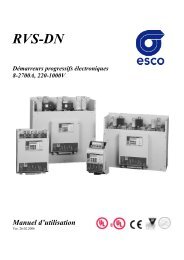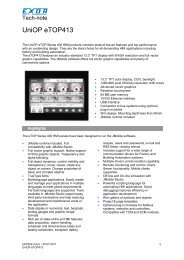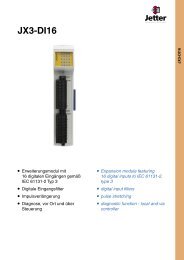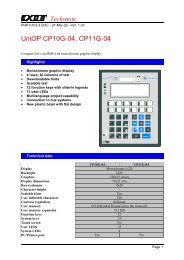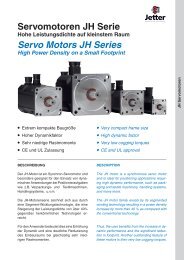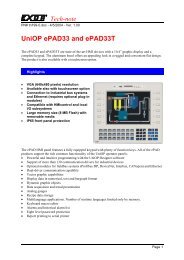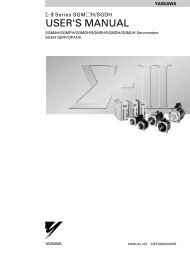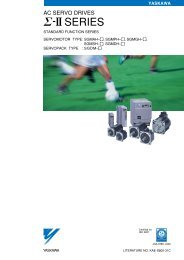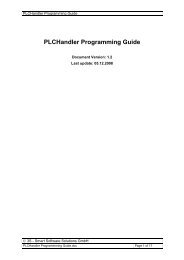eWON General Reference Guide - Esco Drives & Automation
eWON General Reference Guide - Esco Drives & Automation
eWON General Reference Guide - Esco Drives & Automation
You also want an ePaper? Increase the reach of your titles
YUMPU automatically turns print PDFs into web optimized ePapers that Google loves.
<strong>General</strong> <strong>Reference</strong> <strong>Guide</strong><strong>eWON</strong> Configuration3.4 Tag Setup3.4.1 Tag definition: IntroductionThe <strong>eWON</strong> Monitoring Web Interface features are based on:• The configurable monitoring of Tags• The execution of scriptsAll the variables monitored by the <strong>eWON</strong> are defined as "Tags". A Tag is a Boolean or Float value changing with time and coming from a datasource.Typical data-sources are:• <strong>eWON</strong> internal Inputs/Outputs• Remote Inputs/Outputs (modbus, UnitelWay, ...)• <strong>eWON</strong> memory Inputs/Outputs (updated by script)The data source is called an "IO Server". An IO Server is the interface between the changing value and the <strong>eWON</strong> monitoring engine. It is a kindof driver. Any variable from any data source must have a common representation for all IO Servers in order to define common interface in the<strong>eWON</strong>.The data-source representation in the <strong>eWON</strong> uses 3 fields for the definition of a Tag:• The IO Server Name• The Topic name• The Item NameA Tag’s data-source will be uniquely identified with these 3 parameters.IO Server nameTopic NameItem NameIs a kind of driver name. For each IO Server there is a specific Topic Name and Item Namesyntax. The following drivers are available: MODBUS, EWON, MEM, NETMPI, UNITE(Unitelway), DF1, FINS, S7 3&400(MPI), S7 200(PPI) and S5-AS511.Is used to group items inside an IO Server, for example the memory an IO Server uses theblank topic ("") and the retentive topic ("ret"). All the Tags of the MEM IO Server defined in the"ret" topic will have their value saved and restored when the <strong>eWON</strong> boots. All the IO serversdo not use Topic Name. In that case Topic Name must be empty.The item name is a string of characters; its syntax is specific to each IO Server. The ItemName describes the physical variable to monitor using the IO Server.Table 41: Tag’s data-source parametersFor example, the MODBUS IO Server needs to poll registers or coils from a slave, so it uses an item name representation to define the registertype, register address and slave address. (Example "40001,5" => Where 4 means read write register, 0001 is the register number and 5 is theslave Modbus address).A description of the different IO Server syntax is given in chapter “The <strong>eWON</strong> IO Servers” on page 85. Once a Tag is configured with its ServerName, Topic Name and Item Name, it is given a Tag name that will be used everywhere in the <strong>eWON</strong>.3.4.1.1 Tags are stored as FloatInternally, all the tags are stored in single precision FLOAT format (IEEE float representation).This means that you can only expect a maximum precision of 7 decimal digits.That’s why, the 32 bits Integer data read by an IOServer will be automatically converted in the nearest float number representation.For a huge number, it will mean a truncation (ex: integer value 1600000015 will be stored as float 1600000000.0).RG-001-0-EN ver 1.5 <strong>eWON</strong>® - 20/03/2009 - ©ACT'L sa Page 67



